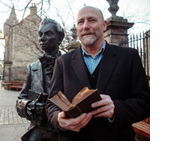Scotland's first medical book : Written in Scots
The work was inspired by the plague outbreak of 1564-69 and Skeyne wrote it in Scots so the common people could either read it themselves or understand it if it was read out to them. This was not a new approach. The book was part of a European-wide phenomenon of vernacular plague tracts which were often penned by physicians who then fled the infected towns.

To alleviate their conscience, they left the tracts for the sick who had often been abandoned to care for themselves. In Skeyne's case, of course, the situation was different. He lived and worked in Aberdeen, whereas his book was printed and distributed in Edinburgh, a city which was ravaged by the plague in 1568-89. It is estimated that it killed about a fifth of the city's inhabitants. The chief part of this and similar tracts is devoted to discussions of the recognition, treatment and prevention of the plague.
View from the Scots Scriever
 Gilbert Skeyne's 'Ane Breve Descriptiovn of the Pest', whiles tae be read aloud, largely uses the norm in Scots prent for its time. The 1560s similarly sees in prent 'The Gude and Godly Ballatis' whaur the zealous Reformers, in recognition o the need tae publish psalms in the 'vulgar tongue', mak mention o the fragility o mortality in the form o the 'pest' or plague:
Gilbert Skeyne's 'Ane Breve Descriptiovn of the Pest', whiles tae be read aloud, largely uses the norm in Scots prent for its time. The 1560s similarly sees in prent 'The Gude and Godly Ballatis' whaur the zealous Reformers, in recognition o the need tae publish psalms in the 'vulgar tongue', mak mention o the fragility o mortality in the form o the 'pest' or plague:
'Thochts pest or sword wald us preune
Befoir our hour, to slay us clean …'
The utilitarian nature o these tracts provides simple explanation as tae why they should be recognisable in a common written an spoken language. Skeyne's plague buik staunds in a period atween Douglas's classical Middle Scots translation o Virgil's 'Aenid' (1513) an when the English ‘Geneva Bible’ wis prentit in Scotland in 1579.
Hamish MacDonald, Scots Scriever
'They having visisted Jonet potnayes child who died suddenly and fearing it to be the plague gross the child died having ane number of black spottis lyke inke …'

